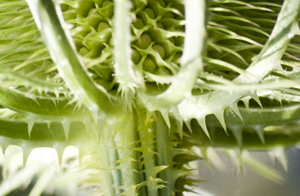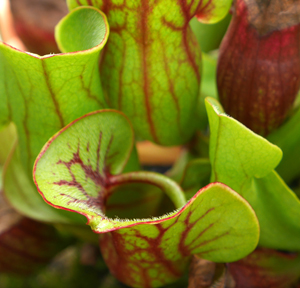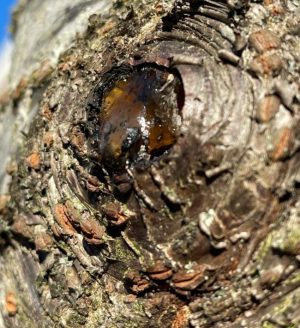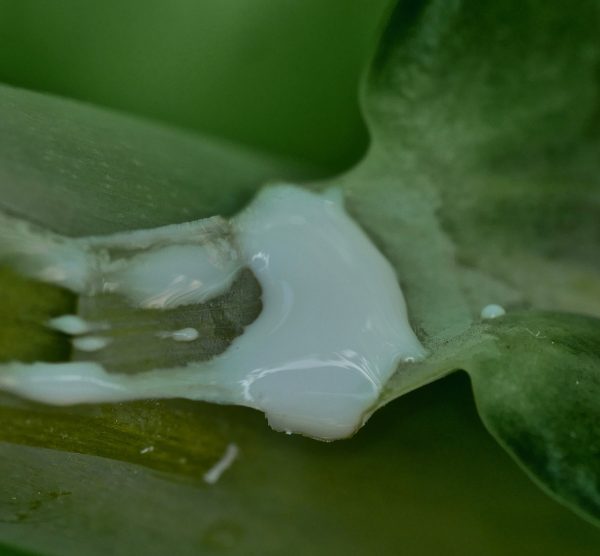How plants defend themselves in an ‘arms race’.

Plants and their ‘predators’ i.e herbivores have been engaged in an “evolutionary arms race” for millions of years. The blog has already explored how thorns, prickles etc act as a defence against larger herbivores. But what about the caterpillars, aphids that feed upon leaves, bark and other tissues ? Thinking of plants as just passive organisms would be wrong; they have a number of strategies that can be deployed.
Some of the defences are physical, like the thorns and prickles. For example, the plant surface (cuticle) may be particularly slippery so that insects find it difficult to adhere or move around. The lips of pitcher plants are ‘slippery’ so that visiting insect slip and fall into the ‘digestive juices’  below. Some flowers (for example, Bonnet Bellflower and some Fritillaria species) have a special layer of wax crystals so that nectar-stealing ants cannot ‘gain purchase’ and the nectar is reserved for the plant’s flying pollinators.
below. Some flowers (for example, Bonnet Bellflower and some Fritillaria species) have a special layer of wax crystals so that nectar-stealing ants cannot ‘gain purchase’ and the nectar is reserved for the plant’s flying pollinators.
Some plants have trichomes (often small hair like structures) which instead of being physical barriers, they release chemicals. For example, trichomes of the wild potato release terpenoids. Terpenoids contribute to the scent of eucalyptus, the flavours of cinnamon, cloves, and ginger, and the yellow colour in sunflowers. The terpenoids of the wild potato are identical to aphid alarm pheromones. Pheromones are the means by which many insects ‘communicate’ with others of their species. These potato terpenoids ‘persuade’ other aphids to stay away.
Another technique some employ is to eliminate the attackers before they can begin to eat. This means detecting the eggs of marauding insects on leaves and stems, and destroying them. Every egg killed means one less caterpillar or adult feeding on the plant. One way in which eggs are destroyed is by the ‘host plant’ producing volatile chemicals (GLV’s) which attract a special type of wasp - wasps which lay their eggs on or in the insect eggs on the leaf. The wasp larvae then feed upon the insects.
Some insects lay their eggs in a chamber within the plant tissues, using an ovipositor.

However, Cherry trees can respond by filling the egg chamber with a sticky gum, this prevents the eggs from hatching. Other plants have resin or latex filled ducts or channels. When damaged the structures in Euphorbias release a latex that takes a long time to harden, which gives the plant time to deliver a ‘cocktail of poisonous compounds’ to stop biting insects. In contrast, the latex of fig (Ficus) hardens quickly, sealing the wound to prevent infection.
A different response is the hypersensitivity response. This involves a degree of ‘self sacrifice’ by a plant. If a leaf detects moth / butterfly eggs on its surface, it may initiate a process whereby the cells underneath the egg(s) produce highly reactive chemicals so that cells on which the eggs are resting - die. The death of the cells changes the immediate environment of the eggs so that the eggs either dry out or fall off. The plant may also set up a ‘signalling pathway’ so that more compounds are produced that make the plant in general less tasty / palatable to herbivores.
The struggle between plants and their ‘predators’ will continue on. If an insect was to become too successful in eating a particular type of plant then in the long term, its offspring would have nothing to eat.

Oozing latex - Euphorbia
Comments are closed for this post.
